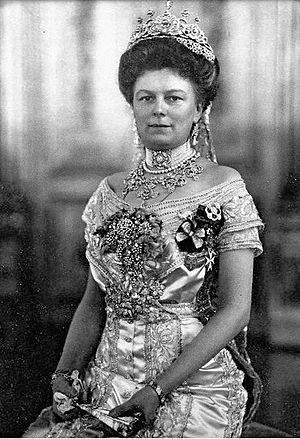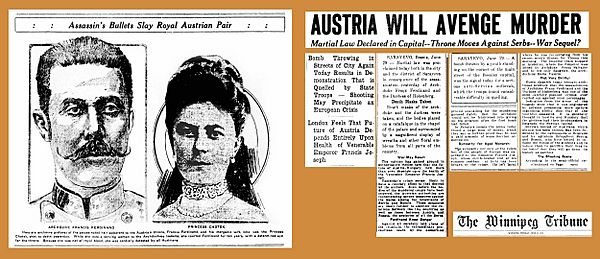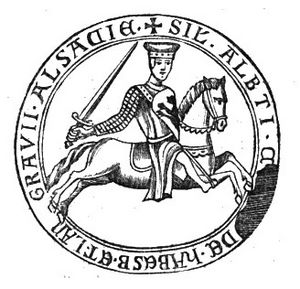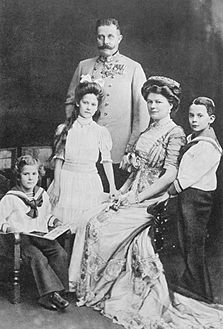Sophie, Duchess of Hohenberg facts for kids
Quick facts for kids Sophie |
|
|---|---|
| Duchess of Hohenberg | |
 |
|
| Sophie c. 1910s | |
| Spouse(s) | |
| Issue | |
|
|
| Full name | |
| Sophie Maria Josephine Albina Chotek von Chotkow und Wognin | |
| Noble family | Chotek |
| Father | Count Bohuslaw Chotek von Chotkow und Wognin |
| Mother | Countess Wilhelmine Kinsky von Wchinitz und Tettau |
| Born | 1 March 1868 Stuttgart, Kingdom of Württemberg |
| Died | 28 June 1914 (aged 46) Sarajevo, Condominium of Bosnia and Herzegovina, Austria-Hungary |
| Burial | Artstetten Castle, Austria |
Sophie, Duchess of Hohenberg (born Sophie Chotek von Chotkow und Wognin on March 1, 1868 – died June 28, 1914) was a noblewoman. She became the wife of Archduke Franz Ferdinand of Austria. He was the next in line to the throne of Austria-Hungary. Their assassination in Sarajevo started a chain of events. These events led to the beginning of World War I just four weeks later.
Contents
Sophie's Early Life
Sophie Chotek was born in Stuttgart. She was the fourth daughter of Count Bohuslav Chotek von Chotkow und Wognin. Her mother was Countess Wilhelmine Kinsky von Wchinitz und Tettau. Sophie's father was a Bohemian aristocrat. He worked as an Ambassador for Austria. He served in different royal courts.
When Sophie was young, she became a lady-in-waiting. This meant she helped Archduchess Isabella. Isabella was married to Archduke Friedrich. He was a powerful figure in the House of Habsburg-Lorraine family.
How Sophie Met Franz Ferdinand
No one knows exactly where Sophie first met Archduke Franz Ferdinand. It might have been at a ball in Prague in 1894. Franz Ferdinand was a soldier stationed in Prague. He often visited Halbturn Castle, Archduke Friedrich's home. People thought he was in love with Friedrich's oldest daughter, Archduchess Marie Christine.
But Archduchess Isabella found out the truth. She found Franz Ferdinand's locket on the tennis court. She opened it, expecting to see her daughter's photo. Instead, it held a picture of Sophie. This discovery caused a big scandal.
Franz Ferdinand was now the next in line to the throne. His uncle, Emperor Franz Joseph, told him he could not marry Sophie. This was because Sophie was not from a royal family. To marry into the Imperial House of Habsburg, a person had to be from a ruling or formerly ruling royal family. The Chotek family were nobles, but they were not considered "royal" enough.
Franz Ferdinand refused to give up Sophie. He would not marry someone else to have an heir to the throne. This added to the problems already facing the royal family.
Marriage to Franz Ferdinand
In 1899, after pressure from family, the couple was allowed to marry. Franz Ferdinand could keep his place as heir to the throne. Sophie would also get a special title. However, Franz Ferdinand had to make a public promise. He promised that Sophie would be his morganatic wife. This meant she would never be empress or queen. Their children would also not be able to inherit the throne. He signed this important document on June 28, 1900.
Sophie and Franz Ferdinand married on July 1, 1900, in Bohemia. The Emperor did not attend the wedding. None of Franz Ferdinand's brothers or other archdukes were there either. Only Franz Ferdinand's stepmother and her two daughters attended.
After her marriage, Sophie became the "Princess of Hohenberg." In 1909, she was given a higher title, "Duchess of Hohenberg."
Despite her new title, Sophie was still treated as being of lower rank. All the princesses and countesses of Austria and Hungary were considered more important than her. For 14 years, Sophie never shared her husband's high rank. Her position at court was often embarrassing. This was made worse by a court official who strictly followed old rules. These rules made Sophie feel less important. Because of these rules, many royal courts did not want to host the couple. However, some did, like King George V and Queen Mary of the United Kingdom. They welcomed Sophie and Franz Ferdinand warmly in 1913.
Sophie and Franz Ferdinand had four children:
- Princess Sophie of Hohenberg (1901–1990)
- Maximilian, Duke of Hohenberg (1902–1962)
- Prince Ernst of Hohenberg (1904–1954)
- A son who was stillborn (1908)
The Assassination

In 1914, Archduke Franz Ferdinand was invited to Sarajevo. This city was the capital of the Austro-Hungarian province of Bosnia and Herzegovina. He was there to watch military exercises. Sophie was not usually allowed on official visits because of her lower status. But this time, Franz Ferdinand was invited as a military commander. So, Sophie was able to join him on June 28. This was the third and final day of the visit. They planned to review troops and visit a new museum. This date was also their 14th wedding anniversary. It was a rare chance for them to celebrate in public.
On Sunday, June 28, 1914, at 10:10 am, their car passed the police station in Sarajevo. A man named Nedeljko Čabrinović threw a hand grenade at their car. The driver sped up, and the grenade exploded under the next car. Two people in that car were badly hurt. Fourteen spectators were also injured by bomb pieces.
After a reception at the City Hall, Franz Ferdinand wanted to visit the wounded in the hospital. A staff member thought this might be dangerous. But General Oskar Potiorek, who was in charge of their safety, disagreed. He asked, "Do you think Sarajevo is full of assassins?" Potiorek did agree that Sophie should stay at the city hall. But Sophie refused. She said, "As long as the Archduke shows himself in public today I will not leave him."
To avoid the city center, Potiorek decided the car should go straight to the hospital. But he forgot to tell the driver, Leopold Loyka. On the way, near the Latin Bridge, the driver turned right. One of the attackers, Gavrilo Princip, was standing there. Potiorek quickly realized the mistake and shouted.
The driver stopped and began to back up slowly. As he did, Gavrilo Princip stepped forward. He pulled out his pistol and fired twice into the car. Franz Ferdinand was shot in the neck. Sophie was hit in her stomach. Sophie asked her husband, "For God's sake, what has happened to you?!" She then collapsed, bleeding. Before he lost consciousness, Franz Ferdinand pleaded, "Sopherl! Sopherl! Don't die! Stay alive for our children!" They both died within an hour.
This assassination started the July Crisis. This crisis then led to the start of the First World War.
Funeral and Burial
The bodies of Sophie and Franz Ferdinand were taken to Trieste by battleship. Then they traveled to Vienna by train. A short funeral service was held at the Hofburg Palace. Only close family members attended. The Archduke and Duchess were then buried side by side. This was his wish. They were laid to rest in the crypt of Artstetten Castle. This was the Habsburg family's summer home. Sophie could not be buried in the main Imperial Crypt. Today, the castle has a museum in their memory.
Commemorative Coin
Artstetten Castle, Sophie's castle, was chosen for a special coin. A 10-euro commemorative coin was made on October 13, 2004. On the back of the coin, you can see the entrance to the Hohenberg family crypt. There are also pictures of Sophie and Archduke Franz Ferdinand.
Images for kids
See also
 In Spanish: Sofía Chotek para niños
In Spanish: Sofía Chotek para niños






